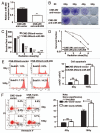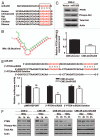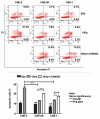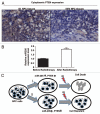MiR-205 determines the radioresistance of human nasopharyngeal carcinoma by directly targeting PTEN
- PMID: 22374676
- PMCID: PMC3356830
- DOI: 10.4161/cc.11.4.19228
MiR-205 determines the radioresistance of human nasopharyngeal carcinoma by directly targeting PTEN
Abstract
Radiotherapy is the primary treatment for nasopharyngeal carcinoma (NPC), but radioresistance severely reduces NPC radiocurability. Here, we have established a radio-resistant NPC cell line, CNE-2R, and investigate the role of miRNAs in radioresistance. The miRNAs microarray assay reveals that miRNAs are differentially expressed between CNE-2R and its parental cell line CNE-2. We find that miR-205 is elevated in CNE-2R. A target prediction algorithm suggests that miR‑205 regulates expression of PTEN, a tumor-suppressor. Introducing miR-205 into CNE-2 cells suppresses PTEN protein expression, followed by activation of AKT, increased number of foci formation and reduction of cell apoptosis postirradiation. On the other hand, knocking down miR-205 in CNE-2R cells compromises the inhibition of PTEN and increases cell apoptosis. Significantly, immunohistochemistry studies demonstrate that PTEN is downregulated at late stages of NPC, and that miR-205 is significantly elevated followed the radiotherapy. Our data conclude that miR-205 contributes to radioresistance of NPC by directly targeting PTEN. Both miR-205 and PTEN are potential predictive biomarkers for radiosensitivity of NPC and may serve as targets for achieve successful radiotherapy in NPC.
Figures







Similar articles
-
miR-150 contributes to the radioresistance in nasopharyngeal carcinoma cells by targeting glycogen synthase kinase-3β.J Cancer Res Ther. 2018 Jan;14(1):111-118. doi: 10.4103/jcrt.JCRT_682_17. J Cancer Res Ther. 2018. PMID: 29516971
-
Activation of miR-21 by STAT3 induces proliferation and suppresses apoptosis in nasopharyngeal carcinoma by targeting PTEN gene.PLoS One. 2014 Nov 3;9(11):e109929. doi: 10.1371/journal.pone.0109929. eCollection 2014. PLoS One. 2014. PMID: 25365510 Free PMC article.
-
MicroRNA-324-3p regulates nasopharyngeal carcinoma radioresistance by directly targeting WNT2B.Eur J Cancer. 2013 Jul;49(11):2596-607. doi: 10.1016/j.ejca.2013.03.001. Epub 2013 Apr 10. Eur J Cancer. 2013. PMID: 23583221
-
Regulatory role of miRNAs in nasopharyngeal cancer involving PTEN/PI3K/AKT, TGFβ/SMAD, RAS/MAPK, Wnt/β-catenin and pRB-E2F signaling pathways: A review.Cell Biochem Funct. 2024 Mar;42(2):e3945. doi: 10.1002/cbf.3945. Cell Biochem Funct. 2024. PMID: 38362935 Review.
-
miRNA as promising theragnostic biomarkers for predicting radioresistance in cancer: A systematic review and meta-analysis.Crit Rev Oncol Hematol. 2021 Jan;157:103183. doi: 10.1016/j.critrevonc.2020.103183. Epub 2020 Nov 27. Crit Rev Oncol Hematol. 2021. PMID: 33310279
Cited by
-
LncRNA RP11-395G23.3 suppresses the endometrial cancer progression via regulating microRNA-205-5p/PTEN axis.Am J Transl Res. 2020 Aug 15;12(8):4422-4433. eCollection 2020. Am J Transl Res. 2020. PMID: 32913516 Free PMC article.
-
Small biomarkers with massive impacts: PI3K/AKT/mTOR signalling and microRNA crosstalk regulate nasopharyngeal carcinoma.Biomark Res. 2022 Jul 26;10(1):52. doi: 10.1186/s40364-022-00397-x. Biomark Res. 2022. PMID: 35883139 Free PMC article. Review.
-
MiRNAs in Radiotherapy Resistance of Nasopharyngeal Carcinoma.J Cancer. 2020 Apr 6;11(13):3976-3985. doi: 10.7150/jca.42734. eCollection 2020. J Cancer. 2020. PMID: 32328201 Free PMC article. Review.
-
The Role of MiR-5094 as a Proliferation Suppressor during Cellular Radiation Response via Downregulating STAT5b.J Cancer. 2020 Feb 3;11(8):2222-2233. doi: 10.7150/jca.39679. eCollection 2020. J Cancer. 2020. PMID: 32127949 Free PMC article.
-
miR-185-3p regulates nasopharyngeal carcinoma radioresistance by targeting WNT2B in vitro.Cancer Sci. 2014 Dec;105(12):1560-8. doi: 10.1111/cas.12555. Epub 2014 Nov 20. Cancer Sci. 2014. PMID: 25297925 Free PMC article.
References
-
- Chang JT, Ko JY, Hong RL. Recent advances in the treatment of nasopharyngeal carcinoma. J Formos Med Assoc. 2004;103:496–510. - PubMed
-
- Mostafa E, Nasar MN, Rabie NA, Ibrahim SA, Barakat HM, Rabie AN. Induction chemotherapy with paclitaxel and cisplatin, followed by concomitant cisplatin and radiotherapy for the treatment of locally advanced nasopharyngeal carcinoma. J Egypt Natl Canc Inst. 2006;18:348–356. - PubMed
-
- Gupta AK, McKenna WG, Weber CN, Feldman MD, Goldsmith JD, Mick R, et al. Local recurrence in head and neck cancer: relationship to radiation resistance and signal transduction. Clin Cancer Res. 2002;8:885–892. - PubMed
Publication types
MeSH terms
Substances
Grants and funding
LinkOut - more resources
Full Text Sources
Molecular Biology Databases
Research Materials
